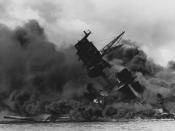During the late 1800's, and throughout the 20th century, Asians in the United States have been perceived as a "yellow peril." The term was first coined in the early 1800s by white Americans who viewed new immigrants from China and other Eastern nations as foreigners with different cultural practices whose presence threatened the stability and peace of the country. The phrase arose at the time when Japanese and Chinese immigration to America was meeting resistance and when Japan was growing as a military power. The Chinese and Japanese were generally believed to be morally deviant and inferior. The United States viewed Asians as dirty, corrupt, treacherous and vindictive.
By the late 1870s, the numbers of Chinese and Asian immigrants who entered California as railroad and agricultural laborers burgeoned. The Chinese flocked to America in search of opportunities during the Gold Rush, particularly because China experienced widespread poverty during that time.
Thus, Asian immigrants faced discrimination from many different groups, including American miners, who felt that the hard-working and low-paid Chinese were reducing their wages. The United States began to set up policies to try and prohibit Asian immigration. By 1882, Congress passed the Chinese Exclusion Act of 1882, prohibiting all Chinese persons, from entering the United States for ten years. The ban on Chinese immigration was extended in 1888, 1892, and 1902. The legislation was not repealed until 1943. In the early twentieth century, Asian immigration remained restricted, and for the most part the Chinese and Japanese remained excluded from white society in ethnic neighborhoods.
By 1939, the Second World War had begun, and the United States remained neutral. During World War II, the Japanese were in desperate need of many natural resources. They decided to take control of the East Indies and Southeast Asia because those areas...


